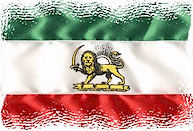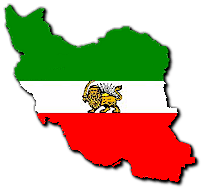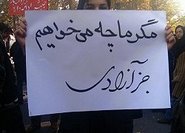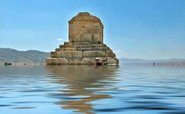Alliance For democracy In Iran
Please have a look at my other weblog, Iran Democracy - http://irandemocray.blogspot.com/
IMPERIAL EMBLEM

PERSIA
Shahanshah Aryameher
S U N OF P E R S I A
Iranian Freedom Fighters UNITE
Saturday, November 15, 2008
Photo show documents death and revolution in Iran
Photo show documents death and revolution in Iran - By Catherine Bosley
"Recording the Truth in Iran" runs from November 10 to December 19.
LONDON (Reuters) - Whether photographing prostitutes in a Tehran brothel or Saddam Hussein's chemical attack against Kurds, Pulitzer Prize-winner Kaveh Golestan wanted to shock viewers "like a slap in the face." Golestan's photographs, which have graced the covers of Time magazine and The Economist, are the subject of the show "Recording the Truth in Iran" at the London School of Economics. Golestan died in 2003 after stepping on a landmine while covering the U.S.-led invasion of Iraq. "His main point was people," Golestan's widow Hengameh told Reuters as she walked along a row of large black and white photographs. "Nobody can ignore the truth," she said, adding that Golestan wrote that he intended his work to slap the viewer in the face.
DIE FOR THEIR BELIEFS
Golestan is best known for his photographs of the riots that brought down Iran's Shah Mohammed Reza Pahlavi in 1979 and ushered in a government based on Islamic law, for which he was awarded a Pulitzer.Among the pictures on display at the LSE is one of a crowd of young men in suits throwing stones at police. In another, a student with a carnation in his hand scratches his head as he stares at a blood-stained pavement.Iranians forced the U.S.-backed Shah, whom they accused of neglecting the poor, from power and replaced him with Ayatollah Ruhollah Khomeini, who had spent some 15 years in exile.When in February 1979 Khomeini returned to Tehran, Golestan was on hand to photograph him getting out of the airplane.During Iran's bloody eight-year conflict with Iraq, Golestan headed for the frontline, covering Iraq's siege of the southern Iranian city of Abadan."I was amazed by how youngsters were willing to die for their beliefs," Golestan said in a quote displayed alongside his pictures at the SE.Because Iran was outmatched by Iraq's military, Khomeini recruited thousands of teenaged boys imbued with religious fervour and sent them into battle."I felt I had to show this though my photos," Golestan said. "I was in search of the deep human feelings that are buried within each person."One of Golestan's photographs on display at the LSE exhibition shows a wounded young soldier lying on the ground, his face a mask of agony and a picture of Khomeini peering out from his shirt pocket.
EXPOSING INJUSTICE
Hengameh, who lives in London, says that among her favourites are her husband's pictures of prostitutes, which he took before the 1979 Islamic revolution. "With prostitutes you usually think they're dirty women. But he totally changed my mind," she says, pointing to a shot of a heavy-set woman clutching a cat. "These people are poor. You can see they're not horrible women."Hengameh says her husband, like many Iranians, initially supported Khomeini.
"The revolution wasn't just mullahs. It was everybody in Iran. He wasn't against the revolution. He was pro-people," she said, adding that Golestan ran into trouble with the shah's regime.
Golestan's first photo exhibition, which featured pictures of children in mental hospitals, was closed down by the shah's secret police."He was always exposing some injustice in Iran," she said.
"Recording the Truth in Iran" runs from November 10 to December 19.
LONDON (Reuters) - Whether photographing prostitutes in a Tehran brothel or Saddam Hussein's chemical attack against Kurds, Pulitzer Prize-winner Kaveh Golestan wanted to shock viewers "like a slap in the face." Golestan's photographs, which have graced the covers of Time magazine and The Economist, are the subject of the show "Recording the Truth in Iran" at the London School of Economics. Golestan died in 2003 after stepping on a landmine while covering the U.S.-led invasion of Iraq. "His main point was people," Golestan's widow Hengameh told Reuters as she walked along a row of large black and white photographs. "Nobody can ignore the truth," she said, adding that Golestan wrote that he intended his work to slap the viewer in the face.
DIE FOR THEIR BELIEFS
Golestan is best known for his photographs of the riots that brought down Iran's Shah Mohammed Reza Pahlavi in 1979 and ushered in a government based on Islamic law, for which he was awarded a Pulitzer.Among the pictures on display at the LSE is one of a crowd of young men in suits throwing stones at police. In another, a student with a carnation in his hand scratches his head as he stares at a blood-stained pavement.Iranians forced the U.S.-backed Shah, whom they accused of neglecting the poor, from power and replaced him with Ayatollah Ruhollah Khomeini, who had spent some 15 years in exile.When in February 1979 Khomeini returned to Tehran, Golestan was on hand to photograph him getting out of the airplane.During Iran's bloody eight-year conflict with Iraq, Golestan headed for the frontline, covering Iraq's siege of the southern Iranian city of Abadan."I was amazed by how youngsters were willing to die for their beliefs," Golestan said in a quote displayed alongside his pictures at the SE.Because Iran was outmatched by Iraq's military, Khomeini recruited thousands of teenaged boys imbued with religious fervour and sent them into battle."I felt I had to show this though my photos," Golestan said. "I was in search of the deep human feelings that are buried within each person."One of Golestan's photographs on display at the LSE exhibition shows a wounded young soldier lying on the ground, his face a mask of agony and a picture of Khomeini peering out from his shirt pocket.
EXPOSING INJUSTICE
Hengameh, who lives in London, says that among her favourites are her husband's pictures of prostitutes, which he took before the 1979 Islamic revolution. "With prostitutes you usually think they're dirty women. But he totally changed my mind," she says, pointing to a shot of a heavy-set woman clutching a cat. "These people are poor. You can see they're not horrible women."Hengameh says her husband, like many Iranians, initially supported Khomeini.
"The revolution wasn't just mullahs. It was everybody in Iran. He wasn't against the revolution. He was pro-people," she said, adding that Golestan ran into trouble with the shah's regime.
Golestan's first photo exhibition, which featured pictures of children in mental hospitals, was closed down by the shah's secret police."He was always exposing some injustice in Iran," she said.
Subscribe to:
Post Comments (Atom)
























 اخبار مربوط به زندانیان سیاسی و نقض حقوق بشر
اخبار مربوط به زندانیان سیاسی و نقض حقوق بشر

















 Tulips in Holland
Tulips in Holland












No comments:
Post a Comment